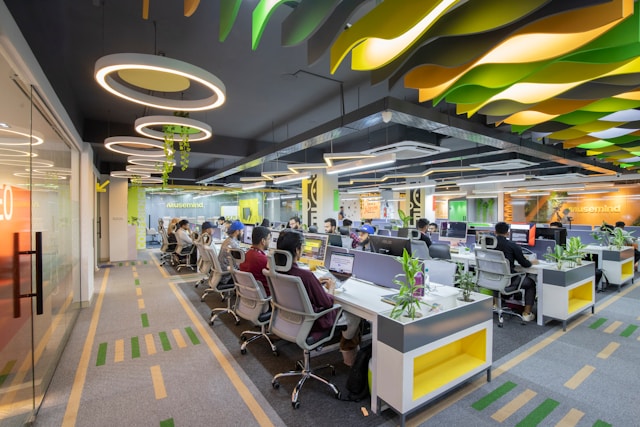Kolkata, popularly called the cultural capital of India, has long been known for its heritage structures, colonial buildings, and thriving business centres. In the last two decades, however, the city has changed. Metro connectivity expansion, new flyovers, IT parks, and commercial complexes have transformed business operations and office design. Urban infrastructure no longer merely facilitates economic activity; it directly influences the way workplaces appear, feel, and function.
Modern businesses in Kolkata must balance the old and the new. At one end, there are old neighbourhoods like Dalhousie and Park Street, where colonial-era offices are retained. On the other hand, large business hubs like Salt Lake’s Sector V and New Town offer futuristic complexes to house IT titans, co-working offices, and start-ups. Such convergence of old and new presents peculiar opportunities and challenges for office design.
The Role of Urban Infrastructure in Office Design
Urban infrastructure directly influences office design. The transport systems of a city, the availability of power, the connectivity of technology, and zoning regulations all influence how workplaces are conceptualised. In Kolkata, where commute times per day are being reduced by an increasing metro system, offices within proximity to metro stations are gaining popularity. This is altering priorities for designers, with companies increasingly demanding layouts that optimise ease of passage and movement for employees.
Availability of retail spaces within multi-storey buildings also alters the manner in which layouts develop. In contrast to traditional single-level offices, contemporary high-rises demand planning of divisions between floors, shared facilities, and breakout rooms. Ease of access to parking lots, elevators, and shared facilities determines the location of cabins, workplaces, and group areas.
In addition, upgrades in infrastructure like improved internet access and stable power supply have facilitated the use of open-plan layouts, technology-enabled meeting rooms, and hybrid work patterns. Without these innovations, contemporary design that focuses on flexibility and digital integration would not be feasible.
Kolkata’s Unique Context
What is fascinating about Kolkata is its dual nature. Classic office complexes in places such as BBD Bagh tend to feature lofty ceilings, arched windows, and not too much flexibility in floor design. On the other hand, New Town has large, glass-faced office skyscrapers designed with sustainability. Office interior designers in Kolkata are challenged to close the gap incorporating contemporary work culture requirements into facilities that are not necessarily suited to classical templates.
The climate of the city is also a consideration. The hot, humid weather of Kolkata requires layouts that emphasise ventilation and climate control. Layouts will frequently include effective HVAC systems, ergonomic seating, and designs that take advantage of natural light while minimising heat. Such sensitivity to regional conditions illustrates how geography and infrastructure influence office design differently across different cities.
Accessibility and Mobility
The most tangible effect of infrastructure growth in Kolkata is enhanced mobility. As metro lines span regions like Salt Lake to business hubs, more firms are opting for office locations in off-centre zones. This has spurred demand for adaptable plans that accommodate younger workforces, such as co-working spaces, open lounges, and recreation areas.
Accessibility has also led to the rise of shared office facilities. Multi-tenant buildings tend to need uniformity in areas open to the public, but in private offices, customisation is most important. At this point, office interior designers’ skills prove to be priceless, as they assist companies in designing distinctive environments within more general infrastructural constraints.
The Push for Sustainable Workspaces
Kolkata, like the other Indian metros, is adopting green infrastructure. Building spaces certified by LEED and GRIHA principles are increasing. Such projects demand office spaces that are compatible with energy efficiency, less waste, and more environmentally friendly materials. For instance, offices will now prioritise designs with centralised recycling, plants, and efficient lighting systems.
This focus on sustainability is redefining how interiors are designed. Spacious areas maximising daylight, breakout areas with live plants, and responsibly sourced materials are no longer design flourishes but the minimum. With corporate social responsibility expanding, most companies in Kolkata opt for offices that incorporate eco-friendly values, and interior designers make sure that these align with infrastructural objectives.
The Role of Office Interior Designers
With so many factors ranging from building type to connectivity by transport, climate, and environmental standards office space design is a task of expertise. This is where office interior designers come in. They translate infrastructural opportunities and constraints, rendering them workable, beautiful, and functional office plans.
For example, in old neighbourhoods where space is scarce, architects might prioritise minimal layouts that optimise functionality. Conversely, new business parks enable testing the limits of large layouts, shared spaces, and integrated innovative technologies. Office interior designers in Kolkata tend to bridge the gap between corporate culture requirements and urban infrastructure realities.
Employee Well-Being and Infrastructure
Design and infrastructure are not merely aesthetics or efficiency; they have a direct impact on the well-being of employees. An office with proximity to major transport stops minimises commute stress. Likewise, designs that include relaxation areas, cafeterias, and wellness spaces enhance morale and productivity.
The presence of support infrastructure like gyms, food courts, and green areas in business complexes has altered the way designs are imagined. Rather than designing offices independently, interior designers today incorporate them into the overall infrastructural environment, making it convenient for employees to access facilities outside the workplace.
Future Trends in Kolkata
As Kolkata’s cityscape develops further, so will its office designs. The new metro routes, smart city developments at New Town, and the growing demand for mixed-use buildings will encourage hybrid architecture that combines private office spaces with common spaces.
Technology will play an even bigger part, with offices boasting virtual conferencing-friendly layouts, AI-managed buildings, and touchless control. With the growth of co-working spaces, flexibility will remain the key spaces that can be readily transformed to address changing tenant requirements will become the norm.
In this regard, office interior designers in Kolkata will play an even more pivotal role. Their capacity to couple infrastructural transformation with changing corporate requirements will establish how effective companies become at designing workspaces that are both functional and motivating.
Conclusion
Urban infrastructure is the unseen structure that organises office design in all cities. In Kolkata, which combines heritage and modernity in a very particular way, this force is particularly strong. Transport systems, types of buildings, climate, and sustainability goals all come together to make what offices are and how they work.
As businesses expand and adapt to global benchmarks, the demand for innovative design solutions will grow even stronger. Office interior designers, particularly those familiar with the city dynamics of Kolkata, will be at the forefront of deciding workplaces that are authentic to the city’s self and representative of its aspirations towards the future.










